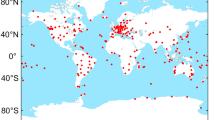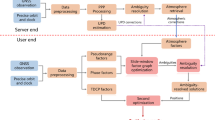Abstract
When a target moves in the field of interest (FOI), the availability of channel sight information is important since the appropriate use of such information can help to improve the localization accuracy. In this paper, Cramer-Rao Lower Bounds (CRLB) for a multi-sensor localization system under different channel sight conditions are computed analytically, which shows that significant degradation in accuracy can happen if channel sight conditions are misidentified. A novel received signal strength (RSS)-based localization algorithm is next proposed. In the algorithm, the FOI is assumed can be divided into distinct non-overlapped cells, and the cells experienced by the moving target are modeled as a hidden Markov model (HMM). Once the HMM matrices are obtained by off-line training, channel sight conditions can be identified by deploying a real time forward-only algorithm. These identified channel sight conditions are used to localize the target. To reduce the position estimation errors which result from the possible misidentified channel sight conditions, a relocalization algorithm is then used to review the identified channel sight conditions once abnormality in position estimate is detected. The simulation results show that our proposed localization strategy can provide good localization performance with the localization error approaching that when all channel sight conditions are known.









Similar content being viewed by others
References
Zhang Y, He S, Chen J (2015) Data gathering optimization by dynamic sensing and routing in rechargeable sensor networks. IEEE/ACM Trans Netw 24(3):1632–1646
Zhang H, Cheng P, Shi L, Chen L (2016) Optimal DoS attack scheduling in wireless networked control system. IEEE Trans Control Syst Technol 24(3):843–852
Chen J, Xu W, He S, Sun Y, Thulasiraman P, Shen X S (2010) Utility-based asynchronous flow control algorithm for wireless sensor networks. IEEE J Sel Areas Commun 28(7):1116–1126
Chen J, Yu Q, Chai B, Sun Y, Fan Y, Shen X (2015) Dynamic channel assignment for wireless sensor networks: a regret matching based approach. IEEE Trans Parallel Distrib Syst 26(1):95– 106
Meng W, Yang Q, Sun Y (2016) Guaranteed performance control of dfig variable-speed wind turbines. IEEE Trans Control Syst Technol. doi:10.1109/TCST.2016.2524531
He J, Cheng P, Shi L, Chen J, Sun Y (2014) Time synchronization in wsns: a maximum-value-based consensus approach. IEEE Trans Autom Control 59(3):660–675
Mao G, Fidan B, Anderson B (2007) Wireless sensor network localization techniques. Comput Netw 51 (10):2529–2553
Yu K, Guo YJ (2009) Statistical NLOS identification based on AOA, TOA, and signal strength. IEEE Trans Veh Technol 58(1):274–286
Fu Y, Ling Q, Tian Z (2012) Distributed sensor allocation for multi-target tracking in wireless sensor networks. IEEE Trans Aerossp Electron Syst 48(4):3538–3553
Chalise BK, Zhang YD, Amin MG, Himed B (2014) Target localization in a multi-static passive radar system through convex optimization. Signal Process 102:207–215
Lin L, So H-C, Chan FKW, Chan YT, Ho KC (2013) A new constrained weighted least squares algorithm for TDOA-based localization. Signal Process 93(11):2872–2878
Doǧançay K, Hmam H (2008) Optimal angular sensor separation for aoa localization. Signal Process 88 (5):1248–1260
Khodjaev J, Park Y, Malik A S (2010) Survey of NLOS identification and error mitigation problems in UWB-based positioning algorithms for dense environments. Ann Telecommun-Annales des Télécommunications 65(5–6):301–311
Yu K, Dutkiewicz E (2013) NLOS identification and mitigation for mobile tracking. IEEE Trans Aerosp Electron Syst 49(3): 1438–1452
Borras J, Hatrack P, Mandayam NB (1998) Decision theoretic framework for NLOS identification. In: 48th IEEE vehicular technology conference, vol 2, pp 1583–1587
Venkatesh S, Buehrer R M (2007) Non-line-of-sight identification in ultra-wideband systems based on received signal statistics. IET Microwaves Antennas Propag 1(6):1120–1130
Heidari M, Akgul F O, Pahlavan K (2007) Identification of the absence of direct path in indoor localization systems. In: IEEE 18th international symposium on personal, indoor and mobile radio communications, pp 1–6
Guvenc I, Chong C-C, Watanabe F (2007) NLOS identification and mitigation for UWB localization systems. In: Wireless communications and networking conference, pp 1571–1576
Chen P (1999) A non-line-of-sight error mitigation algorithm in location estimation. In: IEEE wireless communications and networking conference, pp 316–320
Wu S, Ma Y, Zhang Q, Zhang N (2007) NLOS error mitigation for UWB ranging in dense multipath environments. In: IEEE wireless communications and networking conference , pp 1565–1570
Wann C-D, Hsueh C-S (2007) NLOS mitigation with biased Kalman filters for range estimation in UWB systems. In: IEEE Region 10 conference TENCON, pp 1–4
Morelli C, Nicoli M, Rampa V, Spagnolini U (2007) Hidden Markov models for radio localization in mixed LOS/NLOS conditions. IEEE Trans Signal Process 55(4):1525–1542
Moghtadaiee V, Dempster AG, Lim S (2011) Indoor localization using fm radio signals: a fingerprinting approach. In: 2011 international conference on indoor positioning and indoor navigation (IPIN). IEEE, pp 1–7
Kaemarungsi K, Krishnamurthy P (2012) Analysis of WLAN’s received signal strength indication for indoor location fingerprinting. Pervasive Mob Comput 8(2):292–316
Shi X, Chew Y H, Yuen C, Yang Z (2014) A RSS-EKF localization method using HMM-based LOS/NLOS channel identification. In: 2014 IEEE international conference on communications (ICC). IEEE, pp 160–165
Qi Y, Kobayashi H, Suda H (2006) Analysis of wireless geolocation in a non-line-of-sight environment. IEEE Trans Wirel Commun 5(3):672–681
Hara S, Anzai D, Yabu T, Lee K, Derham T, Zemek R (2013) A perturbation analysis on the performance of TOA and TDOA localization in mixed LOS/NLOS environments. IEEE Trans Commun 61 (2):679–689
Volkov AS (2015) Accuracy bounds of non-gaussian bayesian tracking in a NLOS environment. Signal Process 108:498–508
Yin F, Fritsche C, Gustafsson F, Zoubir A M (2013) Received signal strength-based joint parameter estimation algorithm for robust geolocation in LOS/NLOS environments. In: 2013 IEEE international conference on acoustics, speech and signal processing (ICASSP). IEEE, pp 6471–6475
3rd Generation Partnership Project (3GPP) (2010) Further advancements for EUTRA physical layer aspects (Release 9). 3GPP TR 36.814, V9.0.0
SCM Text V5.0. Spatial channel model text description
Patwari N, Ash JN, Kyperountas S, Hero A O III, Moses R L, Correal Ns S (2005) Locating the nodes: cooperative localization in wireless sensor networks. IEEE Signal Process Mag 22(4): 54–69
Gustafsson F, Gunnarsson F (2005) Mobile positioning using wireless networks: possibilities and fundamental limitations based on available wireless network measurements. IEEE Signal Process Mag 22(4):41–53
Bishop AN, Fidan B, Anderson B, Doǧançay K, Pathirana PN (2010) Optimality analysis of sensor-target localization geometries. Automatica 46(3):479–492
Ucinski D (2000) Optimal sensor location for parameter estimation of distributed processes. Int J Control 73 (13):1235–1248
Yang Z, Shi X, Chen J (2014) Optimal coordination of mobile sensors for target tracking under additive and multiplicative noises. IEEE Trans Ind Electron 61(7):3459–3468
Rabiner LR (1989) A tutorial on hidden Markov models and selected applications in speech recognition. Proc IEEE 77(2):257–286
Acknowledgments
This work is partly supported by 973 Program under Grant 2013CB329503, NSFC under Grant 61371159, and SUTD Temasek Lab (TELAMON – IRPS).
Author information
Authors and Affiliations
Corresponding author
Rights and permissions
About this article
Cite this article
Shi, X., Chew, Y.H., Yuen, C. et al. A novel mobile target localization algorithm via HMM-based channel sight condition identification. Peer-to-Peer Netw. Appl. 10, 808–822 (2017). https://doi.org/10.1007/s12083-016-0484-x
Received:
Accepted:
Published:
Issue Date:
DOI: https://doi.org/10.1007/s12083-016-0484-x




